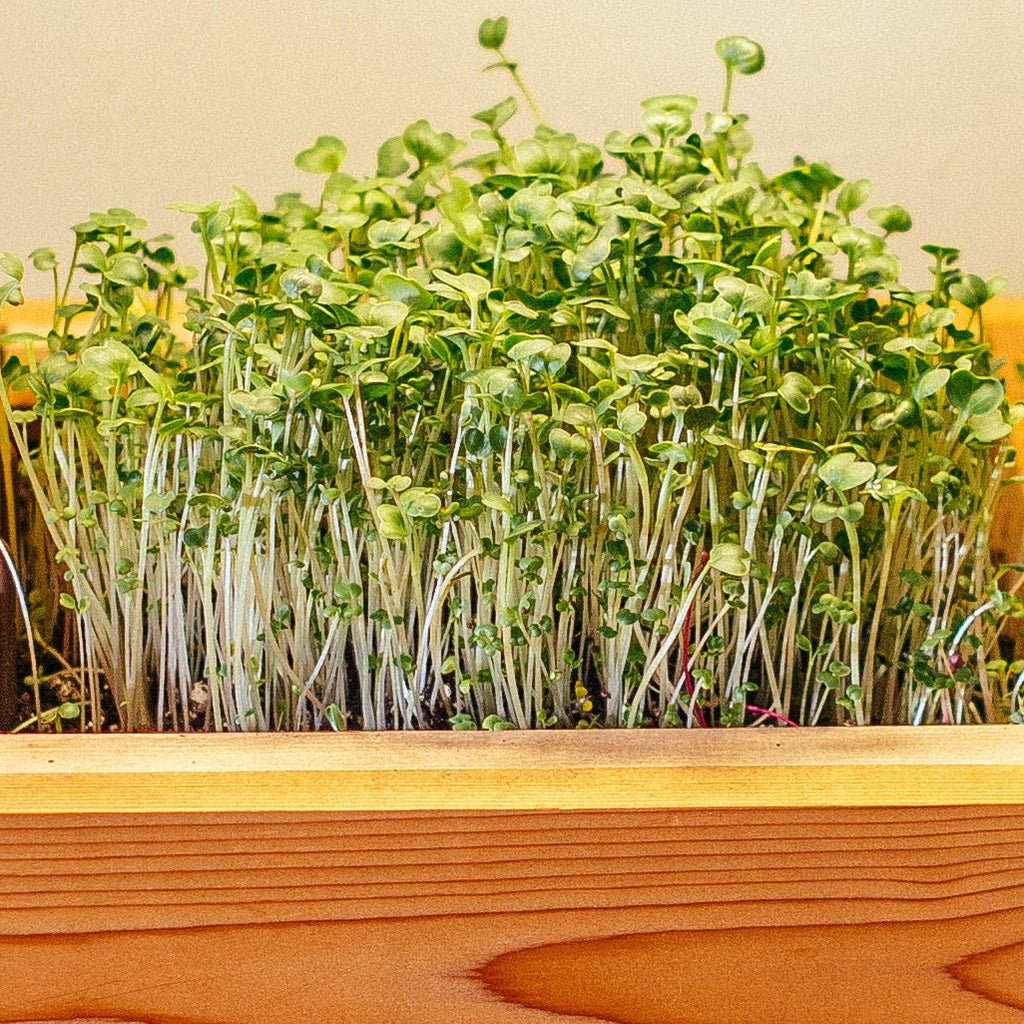Plants
Microgreens : A Gardener's Winter Fix

The turn of the season for many of us means putting the garden to bed for the winter, pulling up tomato plants, and gathering leaves to mulch the summer veggie boxes. If like most home gardeners you don’t have a greenhouse - fall is also the time to say goodbye to the summer lettuce that has filled your salad bowl for months. While delicious produce like hardy winter kale, parsnip or winter squash are plenty to look forward to, nothing replaces the tender sweetness of fresh young greens.
But perhaps you don’t have to give up the greens during the winter months - even without a dedicated greenhouse many urban farmers are getting creative and keeping the warmer months alive indoors with microgreens. Microgreens are what we call nascent veggies harvested after they’ve passed the sprout stage, but before they become baby greens.They are harvested 7 to 14 days after they’ve germinated, when they are one to three inches tall and have seed leaves but not true leaves.
Their flavor could be more intense, yet delicate and fresh than full grown greens, and they take significantly less space to grow. These little sprouts pack a super-sized nutritional punch, and growing them indoors, even in winter months is easier than you think. And, best of all, indoor veggie growing can have surprising benefits for your state of mind.
“Unbelievably” Vitamin Packed

Researchers from the USDA’s agricultural research service analyzed the key nutrients in a variety of microgreens and found that they, “contained considerably higher levels of vitamins and carotenoids—about five times greater—than their mature plant counterparts.” And specific varieties have even higher concentrations of vitamins. Red cabbage microgreens were super-high in vitamin C, garnet amaranth was loaded with vitamin K, daikon radish was chock full of vitamin E, and cilantro was dense with carotenoids - which have been shown to prevent head, neck and lung cancers.
Depending on the type of green they observed anywhere from four to forty times more nutrients than the full blown plant. Those numbers were so staggering, even the scientists were skeptical. They re-checked their analyses several times to be sure there weren’t any mistakes.
The USDA research had only one concern about the use of microgreens: how to keep them fresh and stable after harvest for long enough to reach the consumer. Store bought greens of all sort often travel days, if not weeks before they land in your refrigerator, giving them time to wilt, or even rot, and lose their nutrients. But home-grown greens travel just seconds to your plate, still fresh and full of vitamin-packed flavor.
A Boost for the Wintering Soul

You might have heard of recent studies on Japanese forest bathing - the practice of spending mindful time in natural spaces - and its beneficial effects on health, both physical and mental. But gardeners have always known that you don’t need an entire forest to experience these benefits, all you need is a little dirt beneath your fingertips. And now science has proven that wisdom to be true. Researchers have found that a bacteria common in growing soil, Mycobacterium Vaccae, stimulates serotonin production. Gardeners inhale the bacteria, absorb it through the skin, and otherwise ingest it. If you’ve ever plucked a low hanging cherry tomato and popped it in your mouth, you’ve probably snacked on a bit of Mycobacterium, resulting in a serotonin boost. High serotonin is linked to a sense of calm and well-being.
Indoor gardeners of microgreens are just as likely to get their hands dirty on a regular basis, and encounter these benefits. Winter indoor-gardeners could benefit from them doubly - the serotonin bump could counteract the seasonal mood downshift that comes with receding daylight and gloomy weather. Just make sure the soil in your containers is natural and organic, free of any artificial and chemical-based fertilizers and additives.
Insta-View

A final benefit of indoor greens-gardening is aesthetic. In the darker winter months, when the views of your once colorful garden have fallen back to brown mulch and grey branches, an indoor planting can be a bright and unexpected splash of green. The power of a beautiful natural view shouldn’t be underestimated. Just as we are uplifted by having our hands in the soil, just looking at a scene of growing green can have a positive impact.
A study on patients recovering from surgery tracked the differences between those whose hospital rooms had a green view of the world outside and those whose windows faced a brick wall. Those with a natural view had shorter recovery times, fewer complications, and required less pain medication. If a simple green vista can do all that, what might a close up burst of growing greens do for your home?
Or in other words
What’s not to love about growing indoor micro-greens? A fresh, green view in winter; hands in the soil - even if the ground outside is frozen solid; and nutrient-dense tender greens year round! And they are lovely to sprinkle on hearty winter vegetable soups, or mix into your Christmas leftover sandwiches. Or use them in any of these tasty recipes!